Lifestyle
I spent 4 hours and 20 minutes in the state fair’s new weed lounge. Here’s how it went

Last month, the California State Fair announced plans to allow cannabis to be sold and consumed on-site for the first time in its 170-year history. On Sunday, I hopped on a flight from L.A. to Sacramento, bypassed the stands of deep-fried foods and whooshing carnival rides and made a beeline for Expo 6 to watch the first symbolic smoke sesh firsthand.
Here’s how the first four hours and 20 minutes went down at the fair’s new weed lounge.
Noon
At the back of the California Cannabis Experience, a brightly colored sign beckoned in a font you might find on a vintage postcard: “This way to the Embarc Oasis, ‘High From California.’” Below it, a hastily printed paper sign taped to the double doors reads: “Sales and consumption start at 12:30 p.m.” Organizers explained that the original 11 a.m. opening had been delayed. The reason? Because of an unexpectedly cool morning, the flame retardant applied to the artificial turf in the consumption lounge tent hadn’t yet dried. (That’s right. Organizers were making sure the fake grass didn’t get burned alongside the real grass.)
Trisha Rogers, a fair worker stationed at the front door of the exhibition hall, told me that around 300 people had inquired about the consumption lounge’s opening since the exhibit’s 10 a.m. start. (According to a spokesperson, by the end of the first day, more than 1,000 fair goers visited the lounge.)
Cardboard cutouts of stoner movie characters Harold and Kumar point the way to the California State Fair’s on-site consumption lounge.
12:15 p.m.
Somehow, without anyone in the crowd appearing to notice, one sign came off the double doors and a new one went up. The lounge opening was being pushed back another half hour to 1 p.m. Some in the crowd of 30-plus decided to busy themselves by retracing their steps through the collection of educational, weed-related exhibits. Others bided their time by adding to the Department of Cannabis Control’s nearby display (a large sign that asked “How do you enjoy your weed?” and invited answers by way of sticky notes). A few grabbed CBD-infused slushies from the bar or familiarized themselves with the recently announced 2024 California State Fair Cannabis Award winners whose names and products filled another entire wall.
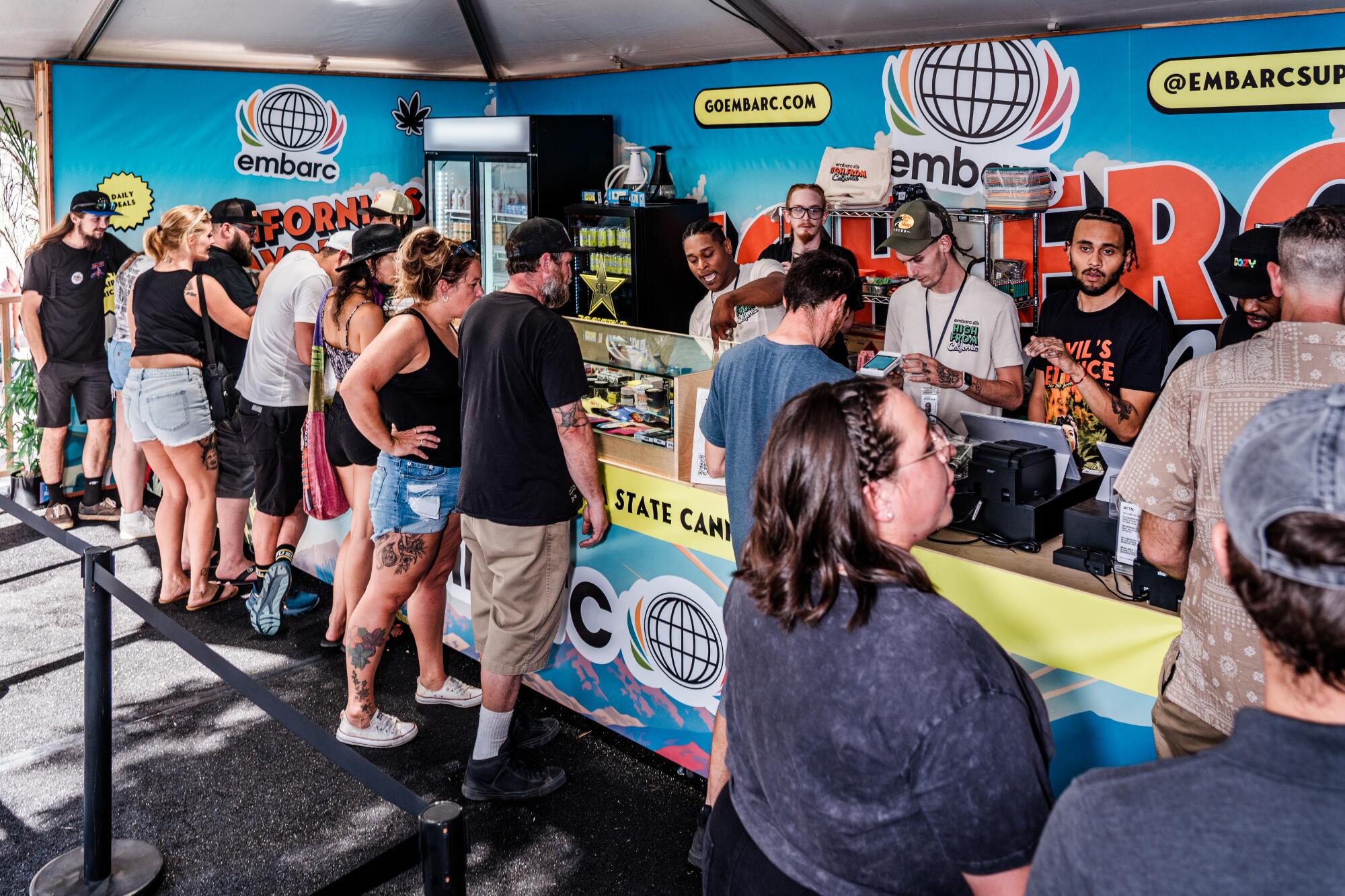
The dispensary run by Embarc, one of two on-site, offers a chance to purchase some of the 2024 award-winning weed honored at the fair.
1:15 p.m.
The doors finally swung open to the cheers of a 60-strong crowd. A sign nearby proclaimed what they already know: “You’re making history today. You’re at the first State Fair in the world where cannabis is being legally sold.”
The first stop in making that history was a visit to the on-site dispensaries (outside cannabis products are not allowed) just on the other side of those double doors. One is run by Embarc, which features some of the 2024 gold medal winners honored in the exhibition (they’re noted with gold stars on the menus), and another is run by the Equity Trade Network, which showcases legacy and social equity brands. (Bringing cash is a smart idea. There are also ATMs throughout the fair.)
The vibe in this indoor/outdoor space was energetic, almost electric as people pointed fingers at the wares inside the glass cases and budtenders scurried about bagging orders. THC-infused edibles and drinks purchased here can be consumed without going elsewhere, but no one seemed to be taking advantage of the few couches in the space.
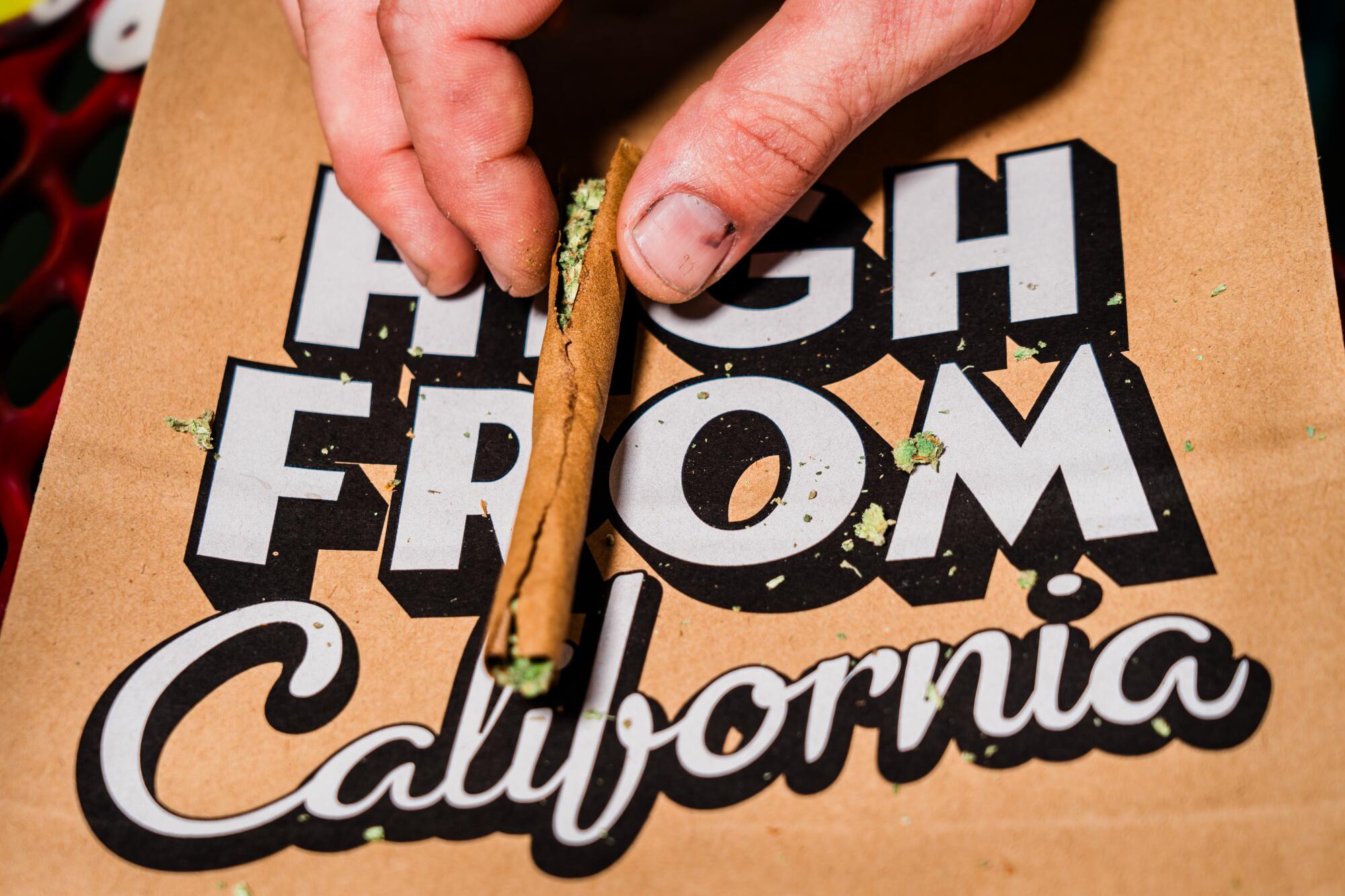
Bobby Dennehy’s freshly rolled, about-to-be-smoked blunt is framed against a dispensary bag emblazoned with “High From California.”
Instead, once their purchases were complete, most people slowly made their way to an exit where they could do one of two things: either hang a right and ease back into the rest of the fair with its fried foods, zooming rides and agricultural displays — but where cannabis consumption is very much not allowed. Or they could enter a gate (clearly marked by cardboard cutouts of stoner movie characters Harold and Kumar), pass through an ID check and then take a short (about .11 miles) stroll along a path that leads under a towering set of bleachers, around the edge of a sports field, ending in a remote tented corner of the fairgrounds that can’t be seen by the general public.
1:20 p.m.
At opening, the mostly empty tent was giving awkward wedding reception vibes. The ground inside was covered completely with artificial turf, and there was a raised stage at one end and two groupings of wooden box-like structures at the other. (Are they seats? Tables? Did it matter?) The propaganda film-turned-cult classic “Reefer Madness” played on a screen at the back of the stage. A few high-top tables were hastily set up when it became apparent there weren’t many suitable places for folks to post up and roll a joint. (Attendees planning to consume on-site should be prepared to roll their own or buy a piece of paraphernalia or papers on-site. Fair rules prohibit bringing your own smoking gear.)
“This is crazy. It’s getting it to where we want it to be — equalized [and] not just treating it like a criminal thing.”
— Ray Ochoa
1:28 p.m.
Ray Ochoa, 28, of Sacramento, stepped into the tent, sparked a CGO Hash Hole (a type of concentrate-infused pre-rolled joint) and became the first person to legally get high at the California State Fair. When told he was the first to fire up, Ochoa let out an enthusiastic whoop. His friends Yogi “Rollz” Romello, 27, and LaMar Mixon, 31, also from Sacramento, followed suit, sparking their own joints and marking the moment.
“This is crazy,” Ochoa said about having a dedicated place to smoke weed at the fair. “It’s getting it to where we want it to be — equalized [and] not just treating it like a criminal thing. We want to be able to smoke with the homies wherever everybody else goes.” His post-partaking plan? “I’m going to go get a little lemonade,” he said. “Gotta mix the terps with the terps. Then I’m just going to go walk around and chill and spend time with the homies.”

The California Cannabis Experience, the gateway to the consumption lounge, includes a wall bearing the question “How do you enjoy your weed?” and invites attendees to answer via sticky note.
1:35 p.m.
On the other side of the tent, a trio of men in wide-brimmed sun hats leaned against a table and got down to business. Pete Telles, 55, of Roseville, Calif., came to the fair with his father, Noel Telles, 85, visiting from Buckeye, Ariz., and their friend from Sacramento, John Matijasic, 73. The latter leaned his cane against the table and focused intently on rolling a joint of Pure Beauty New Jack City (a 2024 indoor flower gold medal winner).
A few attempts later, Matijasic had a functional joint that he proudly lit up and passed to his friends. “I’m smoking dope at the California State Fair,” he said with a sense of bemusement. “After this, I’m going to just sit down and watch people.”
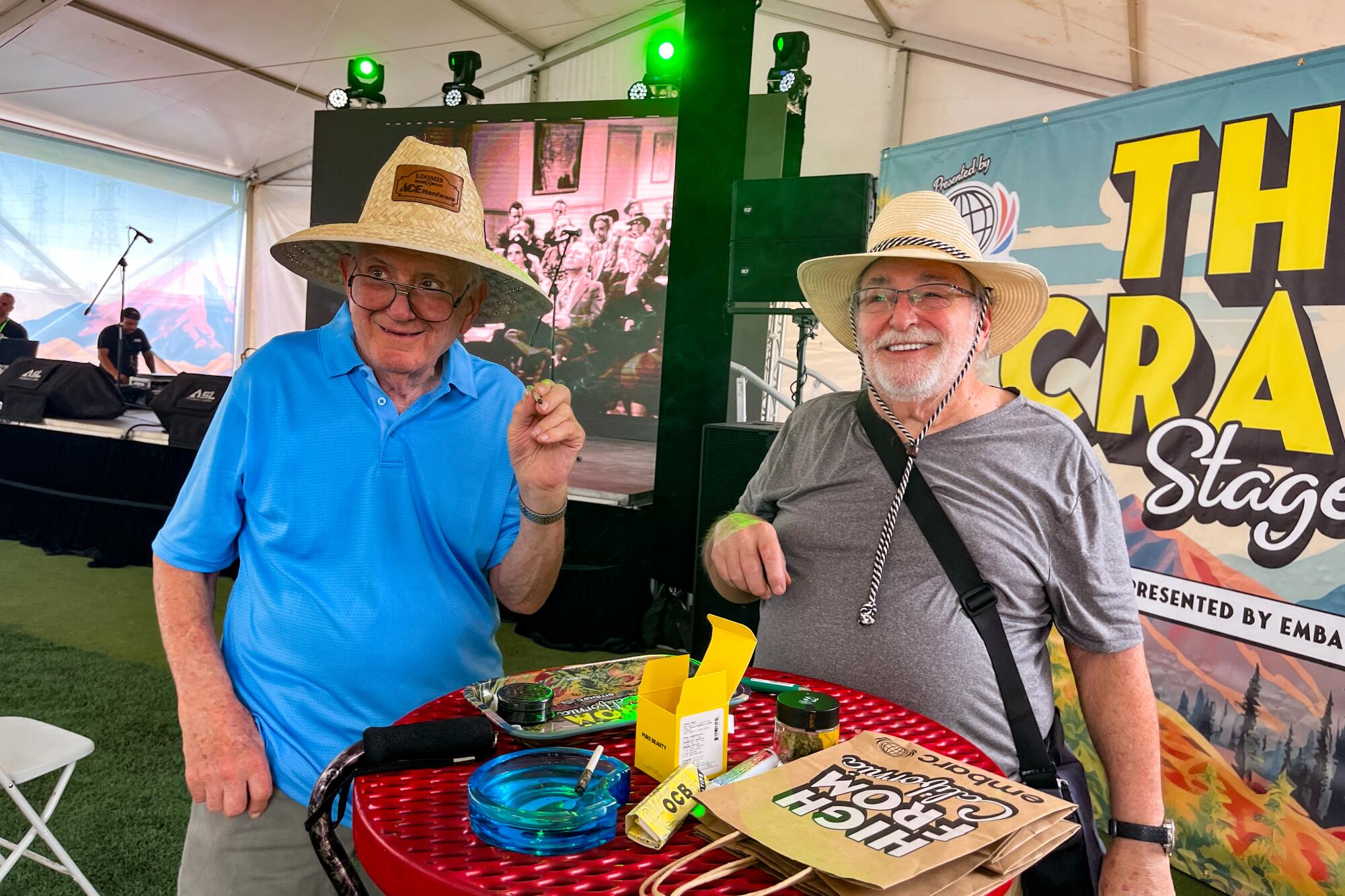
Noel Telles, 85, left, and John Matijasic, 73, are among the first folks to legally light up a joint at the California State Fair. “It doesn’t get any better than this!” Telles told The Times.
(Adam Tschorn / Los Angeles Times)
“This is the exact reason why I’m here today,” Pete Telles said. “To have the ability to purchase and consume and be with like-minded people — and to be with my father, who is a legend to me. We’ve been coming to the fair every year since the mid-’80s.” The younger Telles described being able to consume cannabis legally in public with his father as the best feeling in the world. “It’s like heaven,” he said.
A few puffs later, Noel Telles looked out from under the wide brim of his Ace Hardware sun hat and offered his own assessment. “This is wonderful,” he said. “It doesn’t get any better than this!”
1:53 p.m.
The tent felt less cavernous. Part of that had to do with the 31 people here, most of them smoking up in couples, troikas or quartets, but it also had to do with a handful of folding chairs that materialized out of nowhere. “Reefer Madness” continued to play, but the dialogue was all but drowned out by the social smoking scene. I ducked out of the consumption lounge briefly to stroll the fair. Even though I was very much not high, I managed to eat a sausage the length of my forearm.
3 p.m.
When I returned, Ochoa was gone (presumably on his quest for lemonade), but his buddies Romello and Mixon were holding court near an industrial-sized fan that was circulating their smoke like dry ice vapor across a film set. They were joined by a bunch of friends wearing matching T-shirts emblazoned with the name Frosted Flavors, a Sacramento-based social equity brand specializing in indoor cannabis grown under LED lights.
“[I]t feels like we’re living in the future a little bit …”
— Heidy Santamaria

Heidy Santamaria tries to get a joint rolled in time to spark up in the tent by 4:20 p.m.
(Andri Tambunan / For The Times)
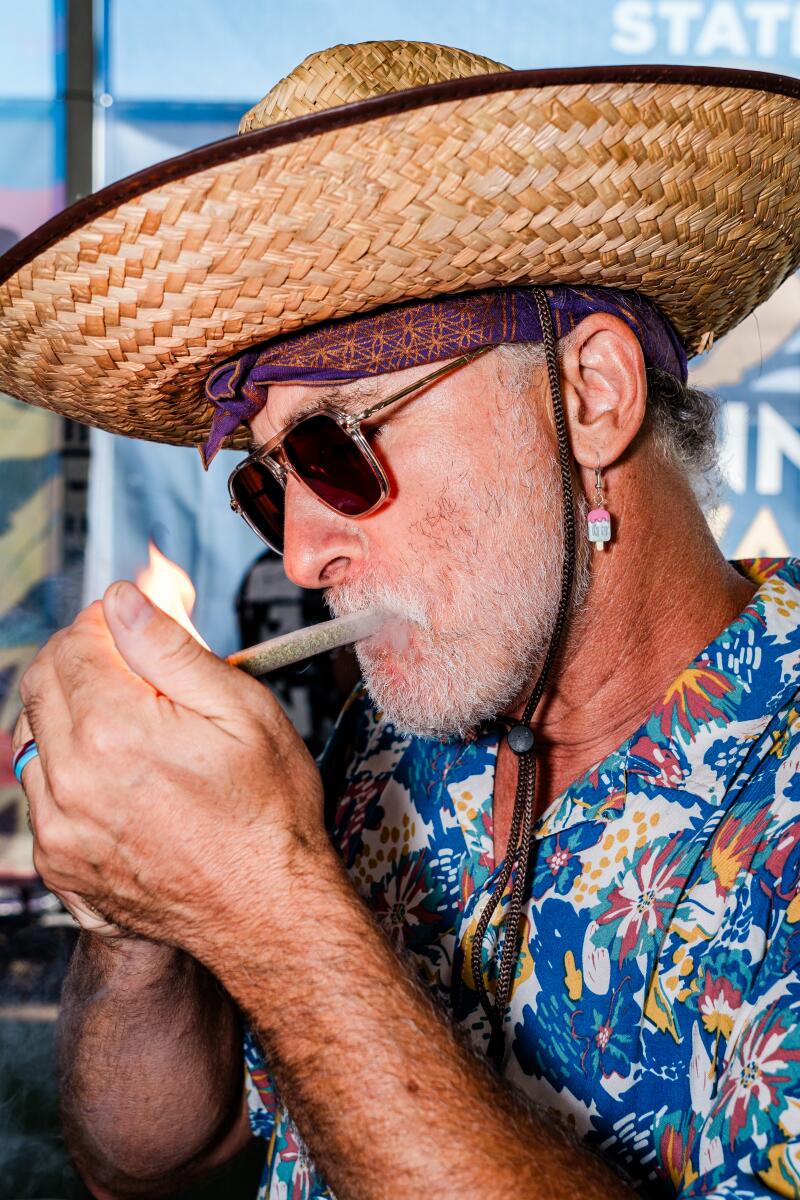
Dustin Mahoney Villafuerte lights up a joint on the first day of legal on-site consumption at the California State Fair.

LaMar Mixon is one of the first three people to light up legally at this year’s state fair along with buddies Ray Ochoa and Yogi Romello (not pictured).
4:15 p.m.
Heidy Santamaria, 26, and Stefania Gagnon, 21, both from Sacramento, sat on folding chairs in the middle of the room. Santamaria was attempting to roll a joint from a jar of Sync SF Strawberry Runtz flower in time for a 4:20 p.m. celebratory smoke. It was a task made more challenging by her exquisite nail art. “This is cool,” Santamaria said about the ability to buy — and consume — cannabis on-site. “I was telling her inside at the little bar[-like] dispensary that it feels like we’re living in the future a little bit. Because when we were growing up, we never thought we’d be able to do something like this.”

A group of cannathusiasts takes to the stage inside the consumption lounge tent at 4:20 p.m. to the sounds of Rick James’ “Mary Jane” and celebrates being able to get high legally at the California State Fair for the first time.
4:20 p.m.
The smoking tent’s population grew to 53, the highest (literally and figuratively) of the day so far. Rick James’ song “Mary Jane” started playing as a handful of celebrants, including the Frosted Flavors guys, took to the stage with joints in hand.
“Welcome to 4:20 for the first time legally at the fair!” someone yelled into the microphone. “Light ’em up!” Everyone in the tent obliged, inhaling deeply and then exhaling one very large — and now very legal — communal cloud of smoke into the air.
Know before you go
There’s no guarantee you’ll have the same level of lounge experience that I did, but if you’re planning to visit the cannabis exhibit at the California State Fair (Cal Expo, 1600 Exposition Blvd., Sacramento), here are a few things you should know:
- Bring a government-issued photo ID card. (You must be 21 to enter.)
- Don’t consume cannabis products outside of the designated lounge.
- If you leave the dispensary or lounge with any opened cannabis product packages, they’ll need to be sealed inside a tamper-proof bag by security personnel upon exiting.
The cannabis exhibit is open from 11 a.m. to 10 p.m. Monday through Thursday and from 10 a.m. to 10 p.m. on Friday, Saturday and Sunday through July 28. Also, the hours for on-site cannabis sales are 11 a.m. to 9 p.m. daily (except for July 19), and the consumption area is open from 11 a.m. to 10 p.m. daily for the duration of the state fair (except for July 19).
Single-day tickets for the fair are $18 for adults and $14 for seniors 62 and older.
Oh, and one more thing: Once you’ve had your history-making smoke, skip the fried foods and carnival rides and instead go right next door to Expo 4. You’ll get to enjoy the visual feast that is the Animation Academy. You can thank me later.

Lifestyle
Timothée Chalamet brings a lot to the table in ‘Marty Supreme’

Timothée Chalamet plays a shoe salesman who dreams of becoming the greatest table tennis player in the world in Marty Supreme.
A24
hide caption
toggle caption
A24
Last year, while accepting a Screen Actors Guild award for A Complete Unknown, Timothée Chalamet told the audience, “I want to be one of the greats; I’m inspired by the greats.” Many criticized him for his immodesty, but I found it refreshing: After all, Chalamet has never made a secret of his ambition in his interviews or his choice of material.
In his best performances, you can see both the character and the actor pushing themselves to greatness, the way Chalamet did playing Bob Dylan in A Complete Unknown, which earned him the second of two Oscar nominations. He’s widely expected to receive a third for his performance in Josh Safdie’s thrilling new movie, Marty Supreme, in which Chalamet pushes himself even harder still.
Chalamet plays Marty Mauser, a 23-year-old shoe salesman in 1952 New York who dreams of being recognized as the greatest table-tennis player in the world. He’s a brilliant player, but for a poor Lower East Side Jewish kid like Marty, playing brilliantly isn’t enough: Simply getting to championship tournaments in London and Tokyo will require money he doesn’t have.

And so Marty, a scrappy, speedy dynamo with a silver tongue and inhuman levels of chutzpah, sets out to borrow, steal, cheat, sweet-talk and hustle his way to the top. He spends almost the entire movie on the run, shaking down friends and shaking off family members, hatching new scams and fleeing the folks he’s already scammed, and generally trying to extricate himself from disasters of his own making.
Marty is very loosely based on the real-life table-tennis pro Marty Reisman. But as a character, he’s cut from the same cloth as the unstoppable antiheroes of Uncut Gems and Good Time, both of which Josh Safdie directed with his brother Benny. Although Josh directed Marty Supreme solo, the ferocious energy of his filmmaking is in line with those earlier New York nail-biters, only this time with a period setting. Most of the story unfolds against a seedy, teeming postwar Manhattan, superbly rendered by the veteran production designer Jack Fisk as a world of shadowy game rooms and rundown apartments.
Early on, though, Marty does make his way to London, where he finagles a room at the same hotel as Kay Stone, a movie star past her 1930s prime. She’s played by Gwyneth Paltrow, in a luminous and long-overdue return to the big screen. Marty is soon having a hot fling with Kay, even as he tries to swindle her ruthless businessman husband, Milton Rockwell, played by the Canadian entrepreneur and Shark Tank regular Kevin O’Leary.
Marty Supreme is full of such ingenious, faintly meta bits of stunt casting. The rascally independent filmmaker Abel Ferrara turns up as a dog-loving mobster. The real-life table-tennis star Koto Kawaguchi plays a Japanese champ who beats Marty in London and leaves him spoiling for a rematch. And Géza Röhrig, from the Holocaust drama Son of Saul, pops up as Marty’s friend Bela Kletzki, a table tennis champ who survived Auschwitz. Bela tells his story in one of the film’s best and strangest scenes, a death-camp flashback that proves crucial to the movie’s meaning.
In one early scene, Marty brags to some journalists that he’s “Hitler’s worst nightmare.” It’s not a stretch to read Marty Supreme as a kind of geopolitical parable, culminating in an epic table-tennis match, pitting a Jewish player against a Japanese one, both sides seeking a hard-won triumph after the horrors of World War II.

The personal victory that Marty seeks would also be a symbolic one, striking a blow for Jewish survival and assimilation — and regeneration: I haven’t yet mentioned a crucial subplot involving Marty’s close friend Rachel, terrifically played by Odessa A’zion, who’s carrying his child and gets sucked into his web of lies.
Josh Safdie, who co-wrote and co-edited the film with Ronald Bronstein, doesn’t belabor his ideas. He’s so busy entertaining you, as Marty ping-pongs from one catastrophe to the next, that you’d be forgiven for missing what’s percolating beneath the movie’s hyperkinetic surface.
Marty himself, the most incorrigible movie protagonist in many a moon, has already stirred much debate; many find his company insufferable and his actions indefensible. But the movies can be a wonderfully amoral medium, and I found myself liking Marty Mauser — and not just liking him, but actually rooting for him to succeed. It takes more than a good actor to pull that off. It takes one of the greats.

Lifestyle
The Best of BoF 2025: A Year of Global Upheaval

Lifestyle
Hungarian filmmaker Béla Tarr — known for bleak, existential movies — has died
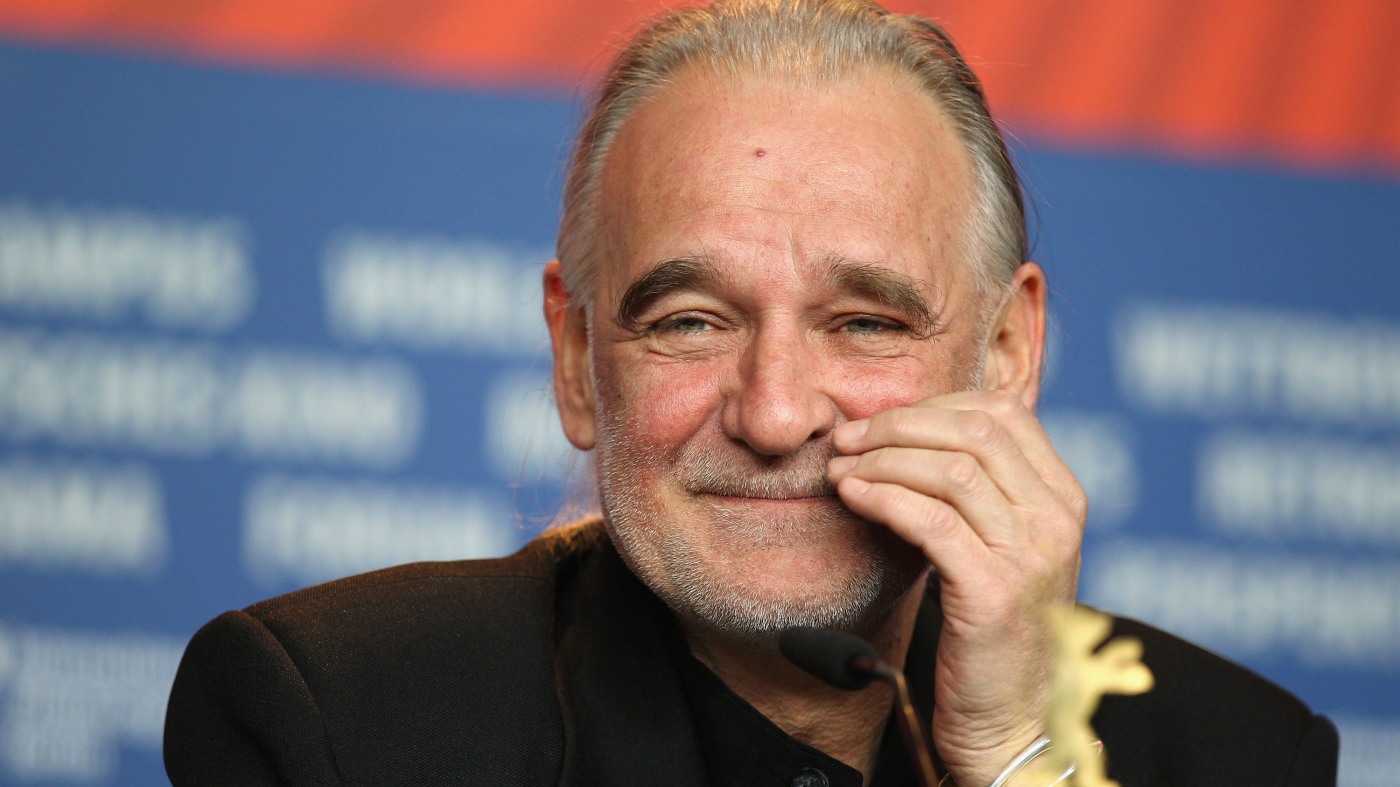
Hungarian director Béla Tarr at the Berlin International Film Festival in 2011.
Andreas Rentz/Getty Images
hide caption
toggle caption
Andreas Rentz/Getty Images
Béla Tarr, the Hungarian arthouse director best known for his bleak, existential and challenging films, including Sátántangó and Werckmeister Harmonies, has died at the age of 70. The Hungarian Filmmakers’ Association shared a statement on Tuesday announcing Tarr’s passing after a serious illness, but did not specify further details.
Tarr was born in communist-era Hungary in 1955 and made his filmmaking debut in 1979 with Family Nest, the first of nine feature films that would culminate in his 2011 film The Turin Horse. Damnation, released in 1988 at the Berlin International Film Festival, was his first film to draw global acclaim, and launched Tarr from a little-known director of social dramas to a fixture on the international film festival circuit.
Tarr’s reputation for films tinged with misery and hard-heartedness, distinguished by black-and-white cinematography and unusually long sequences, only grew throughout the 1990s and 2000s, particularly after his 1994 film Sátántangó. The epic drama, following a Hungarian village facing the fallout of communism, is best known for its length, clocking in at seven-and-a-half hours.
Based on the novel by Hungarian writer László Krasznahorkai, who won the Nobel Prize in Literature last year and frequently collaborated with Tarr, the film became a touchstone for the “slow cinema” movement, with Tarr joining the ranks of directors such as Andrei Tarkovsky, Chantal Akerman and Theo Angelopoulos. Writer and critic Susan Sontag hailed Sátántangó as “devastating, enthralling for every minute of its seven hours.”
Tarr’s next breakthrough came in 2000 with his film Werckmeister Harmonies, the first of three movies co-directed by his partner, the editor Ágnes Hranitzky. Another loose adaptation of a Krasznahorkai novel, the film depicts the strange arrival of a circus in a small town in Hungary. With only 39 shots making up the film’s two-and-a-half-hour runtime, Tarr’s penchant for long takes was on full display.
Like Sátántangó, it was a major success with both critics and the arthouse crowd. Both films popularized Tarr’s style and drew the admiration of independent directors such as Jim Jarmusch and Gus Van Sant, the latter of which cited Tarr as a direct influence on his films: “They get so much closer to the real rhythms of life that it is like seeing the birth of a new cinema. He is one of the few genuinely visionary filmmakers.”
The actress Tilda Swinton is another admirer of Tarr’s, and starred in the filmmaker’s 2007 film The Man from London. At the premiere, Tarr announced that his next film would be his last. That 2011 film, The Turin Horse, was typically bleak but with an apocalyptic twist, following a man and his daughter as they face the end of the world. The film won the Grand Jury Prize at the Berlin International Film Festival.
After the release of The Turin Horse, Tarr opened an international film program in 2013 called film.factory as part of the Sarajevo Film Academy. He led and taught in the school for four years, inviting various filmmakers and actors to teach workshops and mentor students, including Swinton, Van Sant, Jarmusch, Juliette Binoche and Gael García Bernal.
In the last years of his life, he worked on a number of artistic projects, including an exhibition at a film museum in Amsterdam. He remained politically outspoken throughout his life, condemning the rise of nationalism and criticizing the government of Hungarian leader Viktor Orbán.
-

 World1 week ago
World1 week agoHamas builds new terror regime in Gaza, recruiting teens amid problematic election
-

 News1 week ago
News1 week agoFor those who help the poor, 2025 goes down as a year of chaos
-

 Science1 week ago
Science1 week agoWe Asked for Environmental Fixes in Your State. You Sent In Thousands.
-

 Business1 week ago
Business1 week agoA tale of two Ralphs — Lauren and the supermarket — shows the reality of a K-shaped economy
-

 Detroit, MI4 days ago
Detroit, MI4 days ago2 hospitalized after shooting on Lodge Freeway in Detroit
-

 Politics1 week ago
Politics1 week agoCommentary: America tried something new in 2025. It’s not going well
-

 Politics1 week ago
Politics1 week agoMarjorie Taylor Greene criticizes Trump’s meetings with Zelenskyy, Netanyahu: ‘Can we just do America?’
-

 Health1 week ago
Health1 week agoRecord-breaking flu numbers reported in New York state, sparking warnings from officials



















